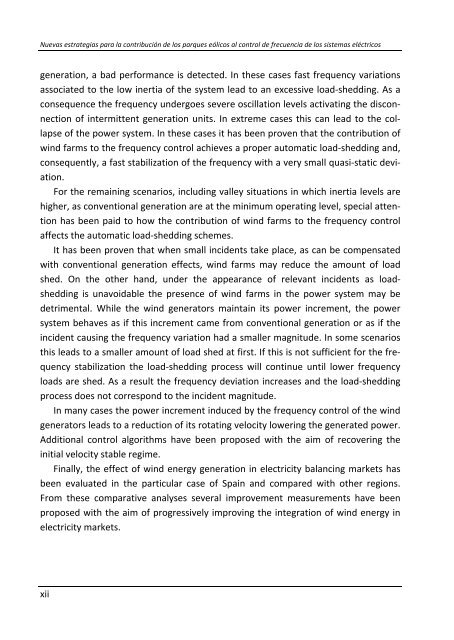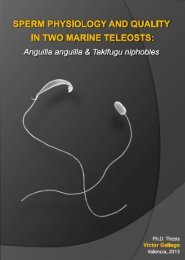- Page 1 and 2: Nuevas estrategias para la contribu
- Page 3 and 4: Fotografía de cubierta: Copyright
- Page 6 and 7: Agradecimientos Me hace tremendamen
- Page 8 and 9: Resumen El número de aerogenerador
- Page 10 and 11: Resum El nombre d’aerogeneradors
- Page 14 and 15: Contenido Agradecimientos v Resumen
- Page 16 and 17: Contenido 5.2. Casos estudiados ...
- Page 18 and 19: Índice de figuras Figura 1.1. Cobe
- Page 20 and 21: Índice de figuras Figura 3.10. Mod
- Page 22 and 23: Índice de figuras Figura 3.41. Án
- Page 24 and 25: Índice de figuras Figura 5.13. Mod
- Page 26 and 27: Índice de figuras Figura 5.39. Var
- Page 28 and 29: Índice de tablas Tabla 2.1. Potenc
- Page 30 and 31: Índice de tablas Tabla 5.1. Indica
- Page 32 and 33: Símbolos a Factor de velocidad ind
- Page 34 and 35: 1. Introducción 1.1. Problemática
- Page 36 and 37: 1. Introducción elevado de aerogen
- Page 38 and 39: 1. Introducción iv) Analizar los e
- Page 40 and 41: 2.1. Tecnología de los aerogenerad
- Page 42 and 43: Potencia capturada P n C C B zona d
- Page 44 and 45: 2. Antecedentes Régimen especial.
- Page 46 and 47: 2. Antecedentes El ciclo combinado
- Page 48 and 49: 2. Antecedentes aprobación del P.O
- Page 50 and 51: Tabla 2.7. Potencia disponible por
- Page 52 and 53: 2. Antecedentes Las instalaciones h
- Page 54 and 55: 2. Antecedentes Sin embargo, cada a
- Page 56 and 57: 2. Antecedentes cidad. La solución
- Page 58 and 59: 2. Antecedentes Como se puede aprec
- Page 60 and 61: 2. Antecedentes EL MERCADO DE PRODU
- Page 62 and 63:
2. Antecedentes siguiente del merca
- Page 64 and 65:
2. Antecedentes Adicionalmente, el
- Page 66 and 67:
ΔP g + − ΔP L 1 2 ⋅ Heqs + D
- Page 68 and 69:
2. Antecedentes Control Error― qu
- Page 70 and 71:
2. Antecedentes Cada día el OS det
- Page 72 and 73:
2. Antecedentes de programación, b
- Page 74 and 75:
2. Antecedentes tirá al OS estimar
- Page 76 and 77:
2. Antecedentes Son precisamente es
- Page 78 and 79:
Referencia adicional de ángulo de
- Page 80 and 81:
Emulación de inercia 2. Antecedent
- Page 82 and 83:
2.4.2. Exigencias en la normativa d
- Page 84 and 85:
2. Antecedentes Tabla 2.10. Rangos
- Page 86 and 87:
2. Antecedentes las mismas exigenci
- Page 88 and 89:
2. Antecedentes El motivo de utiliz
- Page 90 and 91:
Estabilidad Potencia de cortocircu
- Page 92 and 93:
2. Antecedentes Figura 2.22. Tiempo
- Page 94 and 95:
2. Antecedentes El OS comunicará,
- Page 96 and 97:
3. Modelo del aerogenerador Una par
- Page 98 and 99:
3. Modelo del aerogenerador con una
- Page 100 and 101:
3. Modelo del aerogenerador mas de
- Page 102 and 103:
3.3. Turbina eólica 3. Modelo del
- Page 104 and 105:
Tabla 3.1. Diámetro y velocidad de
- Page 106 and 107:
3. Modelo del aerogenerador velocid
- Page 108 and 109:
3. Modelo del aerogenerador potenci
- Page 110 and 111:
3. Modelo del aerogenerador 2R/v. S
- Page 112 and 113:
ω t Teoría del elemento de pala
- Page 114 and 115:
C L, C D 1.4 1.3 1.2 1.1 1 0.9 0.8
- Page 116 and 117:
3. Modelo del aerogenerador necesar
- Page 118 and 119:
2.5. Se repiten los pasos 2.2, 2.3
- Page 120 and 121:
3. Modelo del aerogenerador igual a
- Page 122 and 123:
3. Modelo del aerogenerador cambio
- Page 124 and 125:
3. Modelo del aerogenerador orden d
- Page 126 and 127:
3. Modelo del aerogenerador A conti
- Page 128 and 129:
3. Modelo del aerogenerador dad. Pa
- Page 130 and 131:
3. Modelo del aerogenerador Tabla 3
- Page 132 and 133:
3. Modelo del aerogenerador donde a
- Page 134 and 135:
τ ω = 60 s K pt = 3,0 Kit = 0,6 P
- Page 136 and 137:
* ωg − Kit K pt + + s T em,min T
- Page 138 and 139:
3. Modelo del aerogenerador Tambié
- Page 140 and 141:
Peol (p.u.) 1,0 0,8 0,6 0,4 0,2 0 2
- Page 142 and 143:
3. Modelo del aerogenerador velocid
- Page 144 and 145:
* ωcp − + K pp β min β max K +
- Page 146 and 147:
3. Modelo del aerogenerador Como re
- Page 148 and 149:
3. Modelo del aerogenerador velocid
- Page 150 and 151:
3. Modelo del aerogenerador Además
- Page 152 and 153:
3. Modelo del aerogenerador El mayo
- Page 154 and 155:
* * cp cp 3. Modelo del aerogenerad
- Page 156 and 157:
3. Modelo del aerogenerador propues
- Page 158 and 159:
3. Modelo del aerogenerador Estos d
- Page 160 and 161:
3. Modelo del aerogenerador pala cu
- Page 162 and 163:
12 10 8 β( 6 ◦ ) 4 2 0 0 20 40 6
- Page 164 and 165:
3. Modelo del aerogenerador En la F
- Page 166 and 167:
(1 + τzs) ms () = K (1 + τ s) p 3
- Page 168 and 169:
3. Modelo del aerogenerador La gana
- Page 170 and 171:
3. Modelo del aerogenerador ye, aun
- Page 172 and 173:
3. Modelo del aerogenerador mico se
- Page 174 and 175:
4. Modelo del sistema eléctrico Pa
- Page 176 and 177:
4. Modelo del sistema eléctrico Ad
- Page 178 and 179:
4. Modelo del sistema eléctrico me
- Page 180 and 181:
4. Modelo del sistema eléctrico Ta
- Page 182 and 183:
4. Modelo del sistema eléctrico se
- Page 184 and 185:
avamax ava 4. Modelo del sistema el
- Page 186 and 187:
4. Modelo del sistema eléctrico Cu
- Page 188 and 189:
4. Modelo del sistema eléctrico po
- Page 190 and 191:
4. Modelo del sistema eléctrico En
- Page 192 and 193:
4. Modelo del sistema eléctrico pr
- Page 194 and 195:
4. Modelo del sistema eléctrico Ta
- Page 196 and 197:
4. Modelo del sistema eléctrico En
- Page 198 and 199:
5. Control de frecuencia en aerogen
- Page 200 and 201:
Subfrecuencia Sobrefrecuencia 5. Co
- Page 202 and 203:
5. Control de frecuencia en aerogen
- Page 204 and 205:
5. Control de frecuencia en aerogen
- Page 206 and 207:
5. Control de frecuencia en aerogen
- Page 208 and 209:
5. Control de frecuencia en aerogen
- Page 210 and 211:
5. Control de frecuencia en aerogen
- Page 212 and 213:
5. Control de frecuencia en aerogen
- Page 214 and 215:
5. Control de frecuencia en aerogen
- Page 216 and 217:
5. Control de frecuencia en aerogen
- Page 218 and 219:
5. Control de frecuencia en aerogen
- Page 220 and 221:
5. Control de frecuencia en aerogen
- Page 222 and 223:
5. Control de frecuencia en aerogen
- Page 224 and 225:
5. Control de frecuencia en aerogen
- Page 226 and 227:
5. Control de frecuencia en aerogen
- Page 228 and 229:
5. Control de frecuencia en aerogen
- Page 230 and 231:
5. Control de frecuencia en aerogen
- Page 232 and 233:
5. Control de frecuencia en aerogen
- Page 234 and 235:
5. Control de frecuencia en aerogen
- Page 236 and 237:
5. Control de frecuencia en aerogen
- Page 238 and 239:
5. Control de frecuencia en aerogen
- Page 240 and 241:
5. Control de frecuencia en aerogen
- Page 242 and 243:
5. Control de frecuencia en aerogen
- Page 244 and 245:
5. Control de frecuencia en aerogen
- Page 246 and 247:
5. Control de frecuencia en aerogen
- Page 248 and 249:
0,89 T (p.u.) 0,85 0,81 1,21 ωg(p.
- Page 250 and 251:
5. Control de frecuencia en aerogen
- Page 252 and 253:
5. Control de frecuencia en aerogen
- Page 254 and 255:
5. Control de frecuencia en aerogen
- Page 256 and 257:
1,05 T (p.u.) 0,94 0,83 1,32 ωg(p.
- Page 258 and 259:
5. Control de frecuencia en aerogen
- Page 260 and 261:
5. Control de frecuencia en aerogen
- Page 262 and 263:
5. Control de frecuencia en aerogen
- Page 264 and 265:
5. Control de frecuencia en aerogen
- Page 266 and 267:
Filtro washout 5. Control de frecue
- Page 268 and 269:
6. Efectos de la eólica en los mer
- Page 270 and 271:
6. Efectos de la eólica en los mer
- Page 272 and 273:
6. Efectos de la eólica en los mer
- Page 274 and 275:
6. Efectos de la eólica en los mer
- Page 276 and 277:
6. Efectos de la eólica en los mer
- Page 278 and 279:
6. Efectos de la eólica en los mer
- Page 280 and 281:
6. Efectos de la eólica en los mer
- Page 282 and 283:
7.1. Conclusiones 7. Conclusiones,
- Page 284 and 285:
Contribución de los parques eólic
- Page 286 and 287:
7. Conclusiones, aportaciones y tra
- Page 288 and 289:
7.2. Aportaciones más relevantes 7
- Page 290 and 291:
Anexo A. Parámetros de aerogenerad
- Page 292 and 293:
Bibliografía Acciona (2005). Apart
- Page 294 and 295:
Bibliografía Bola Merino, J. (2010
- Page 296 and 297:
Bibliografía Gobierno de España (
- Page 298 and 299:
Bibliografía Lalor, G., A. Mullane
- Page 300 and 301:
Bibliografía Pourbeik, P. y F. Mod
- Page 302 and 303:
Bibliografía Slootweg, J. G., H. P

















